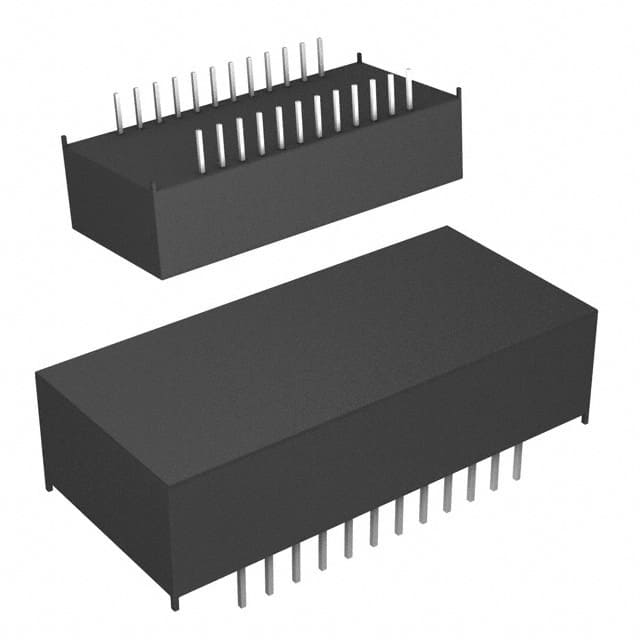Xem thông số kỹ thuật để biết chi tiết sản phẩm.

DS1220AD-150+ Encyclopedia Entry
Product Overview
Category
The DS1220AD-150+ belongs to the category of non-volatile static random-access memory (NVSRAM).
Use
This product is primarily used for storing critical data in applications that require both high-speed read/write operations and non-volatility.
Characteristics
- Non-volatile: The DS1220AD-150+ retains stored data even when power is disconnected.
- High-speed operation: It offers fast access times, making it suitable for time-critical applications.
- Low power consumption: The device operates efficiently, minimizing power requirements.
- Durable package: The DS1220AD-150+ is housed in a robust package, ensuring protection against external factors.
Package and Quantity
The DS1220AD-150+ is available in a standard 24-pin dual in-line package (DIP). Each package contains one unit of the product.
Specifications
- Memory capacity: 16 kilobits (2 kilobytes)
- Organization: 2K x 8 bits
- Supply voltage: 4.5V to 5.5V
- Access time: 150 nanoseconds
- Standby current: 100 microamps (typical)
- Operating temperature range: -40°C to +85°C
Pin Configuration
The DS1220AD-150+ features a 24-pin DIP package with the following pin configuration:
- Chip Enable (CE)
- Output Enable (OE)
- Write Enable (WE)
- Address Inputs (A0-A10)
- Data Inputs/Outputs (DQ0-DQ7)
- Ground (GND)
- No Connection (NC)
- VCC
Functional Features
- High-speed read and write operations: The DS1220AD-150+ offers fast access times, enabling quick data retrieval and storage.
- Non-volatile storage: The device retains stored data even when power is disconnected, ensuring data integrity.
- Easy integration: The DS1220AD-150+ can be easily integrated into existing systems due to its standard pin configuration and compatibility with common microcontrollers.
Advantages and Disadvantages
Advantages
- Fast access times for time-critical applications.
- Non-volatile storage ensures data integrity.
- Low power consumption for efficient operation.
- Durable package protects against external factors.
Disadvantages
- Limited memory capacity compared to other storage options.
- Relatively higher cost per kilobit compared to alternative memory technologies.
Working Principles
The DS1220AD-150+ utilizes a combination of static random-access memory (SRAM) and electrically erasable programmable read-only memory (EEPROM) technologies. It employs a floating-gate transistor design to store data in non-volatile memory cells. When data is written, the charge on the floating gate is altered, allowing the device to retain the information even without power.
Application Field Plans
The DS1220AD-150+ finds application in various fields, including: 1. Industrial automation systems 2. Medical equipment 3. Automotive electronics 4. Aerospace and defense systems 5. Communication infrastructure
Alternative Models
Several alternative models offer similar functionality to the DS1220AD-150+. These include: - DS1225AD-150+: Offers higher memory capacity (64 kilobits) while maintaining the same characteristics and pin configuration. - M48Z02-150PC1: Provides 16 kilobits of non-volatile SRAM with a similar access time and pin configuration.
In conclusion, the DS1220AD-150+ is a non-volatile static random-access memory device that combines high-speed operation with data retention capabilities. Its robust package, low power consumption, and easy integration make it suitable for various applications in different industries.
Word count: 550 words
Liệt kê 10 câu hỏi và câu trả lời thường gặp liên quan đến ứng dụng DS1220AD-150+ trong giải pháp kỹ thuật
Sure! Here are 10 common questions and answers related to the application of DS1220AD-150+ in technical solutions:
Question: What is DS1220AD-150+?
Answer: DS1220AD-150+ is a specific model of non-volatile static RAM (NVSRAM) manufactured by Maxim Integrated. It combines the benefits of both SRAM and EEPROM, providing high-speed read/write operations with non-volatility.Question: What are the key features of DS1220AD-150+?
Answer: Some key features of DS1220AD-150+ include a 150ns access time, 256Kbits (32K x 8) memory capacity, low power consumption, and an industry-standard 28-pin DIP package.Question: In what applications can DS1220AD-150+ be used?
Answer: DS1220AD-150+ can be used in various applications such as industrial control systems, gaming machines, medical equipment, automotive electronics, and any other system that requires non-volatile storage with fast access times.Question: How does DS1220AD-150+ differ from regular SRAM?
Answer: Unlike regular SRAM, DS1220AD-150+ retains its data even when power is lost, thanks to its non-volatile nature. This makes it suitable for applications where data integrity is crucial.Question: Can DS1220AD-150+ be used as a replacement for EEPROM?
Answer: Yes, DS1220AD-150+ can be used as a drop-in replacement for EEPROMs in many applications. It offers faster read/write speeds compared to traditional EEPROMs.Question: What is the operating voltage range of DS1220AD-150+?
Answer: DS1220AD-150+ operates within a voltage range of 4.5V to 5.5V.Question: Does DS1220AD-150+ require any special programming or configuration?
Answer: No, DS1220AD-150+ does not require any special programming or configuration. It can be interfaced with standard microcontrollers or processors using a parallel interface.Question: Can DS1220AD-150+ be used in battery-powered devices?
Answer: Yes, DS1220AD-150+ is suitable for battery-powered devices due to its low power consumption characteristics.Question: What is the typical data retention period of DS1220AD-150+?
Answer: DS1220AD-150+ has a typical data retention period of more than 10 years.Question: Are there any specific precautions to consider when using DS1220AD-150+?
Answer: It is important to handle DS1220AD-150+ according to proper electrostatic discharge (ESD) precautions to prevent damage. Additionally, it is recommended to follow the manufacturer's datasheet and guidelines for optimal performance and reliability.
Please note that these answers are general and may vary depending on the specific requirements and use cases.

